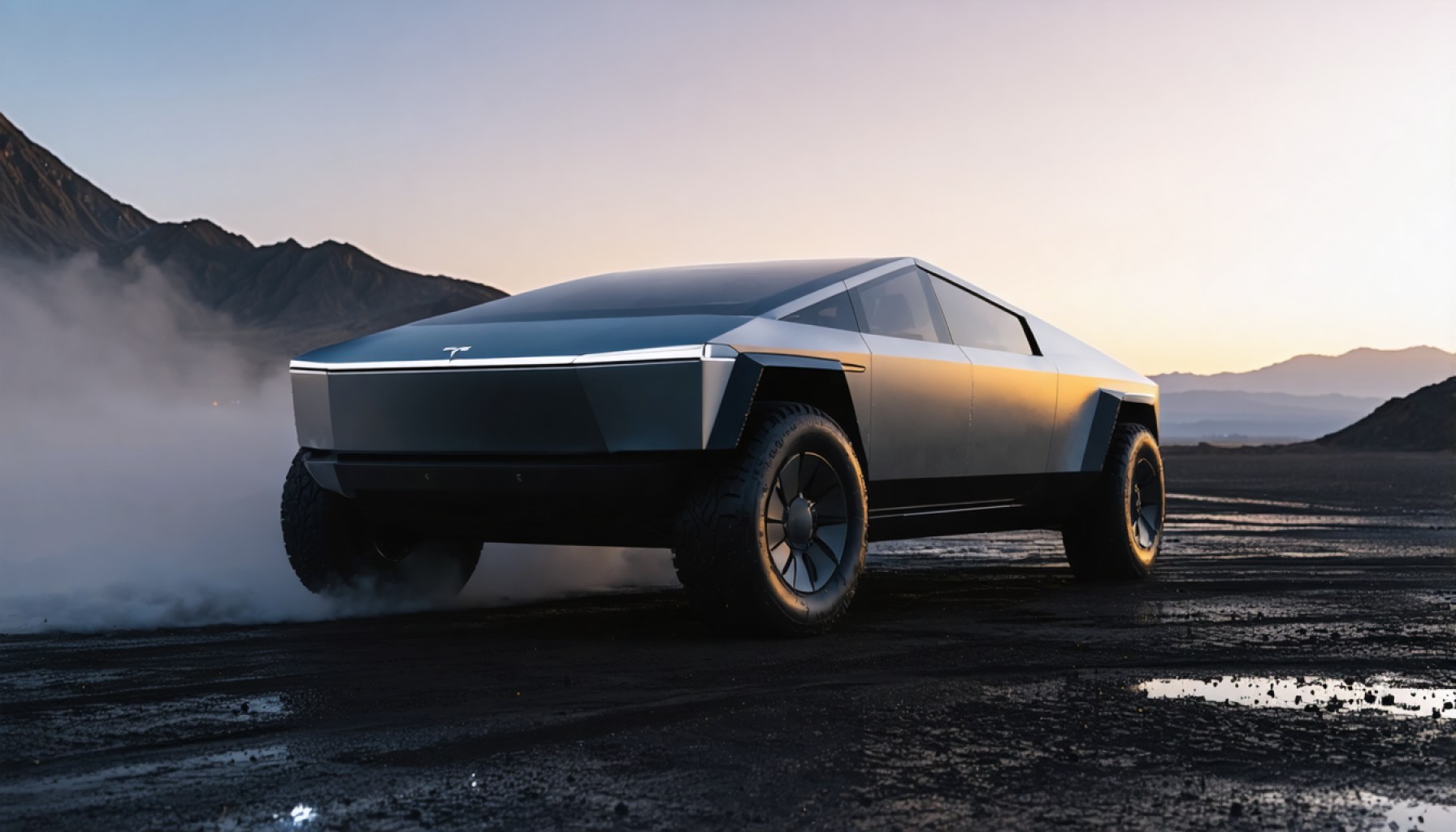- Tesla faces significant challenges in 2025, centered on its struggling Cybertruck model.
- A massive inventory of Cybertrucks, valued at nearly $200 million, remains unsold, leading to a 13% decline in first-quarter sales.
- Tesla’s decision not to accept Cybertrucks as trade-ins leaves customers to navigate “Lemon Law” protections for defective vehicles.
- Former President Trump’s support underscores the complexity and public scrutiny Tesla faces.
- The situation highlights the importance of adaptability and resilience for even the most innovative companies like Tesla.
- Tesla’s ability to regain its audience’s inspiration and confidence is crucial moving forward.
Beneath the skyscrapers of Silicon Valley, a chilling breeze ripples through the air—a stark contrast to the usual effervescent hum surrounding Tesla. The renowned electric vehicle giant is grappling with turmoil as it navigates the treacherous waters of early 2025. The heart of the storm centers around its futuristic Cybertruck, which has now become a symbol of the challenges facing the company.
Picture a gleaming fleet of Cybertrucks, each a masterpiece of innovation with its stainless steel exoskeleton and angular design, sitting in limbo on Tesla’s lots. This image captures the growing inventory reportedly valued at nearly $200 million, a testament to the unexpected struggles of selling these avant-garde vehicles. Once hailed as a game-changer in the automotive world, the Cybertruck’s allure appears to be waning, with the company now facing a steep drop in first-quarter sales—a stark 13% slump.
Behind the scenes, Tesla is making headlines for its refusal to accept Cybertrucks back as trade-ins—a decision that reverberates like a seismic shock through its loyal customer base. The realization hits hard for many owners who hoped to seamlessly transition to another Tesla model. Instead, they now face the arduous journey through the “Lemon Law” process, a legal avenue designed to safeguard consumers stuck with defective products.
For the uninitiated, lemon laws are a critical lifeline, safeguarding anyone who unwittingly buys a problematic vehicle. They form the last bastion for frustrated Cybertruck owners eager to cut ties with their once-prized possession. Turning this route into a bureaucratic dance, Tesla finds itself at odds with its patrons, leaving them mired in frustration.
Even the fiery rhetoric of former President Donald Trump, who filled the White House with Tesla’s glistening cars in a show of solidarity for CEO Elon Musk, can’t quell the anxiety. With a voice as commanding as ever, Trump pledged allegiance to Musk’s vision, declaring that protests against Tesla harm “a great American company.” But beneath this bold advocacy lies a much more complex narrative for Tesla and its entrepreneurial vanguard.
The takeaway resonates like an echoing drum: Even the most groundbreaking companies can face profound challenges when the market takes a turn. Tesla’s story underscores the importance of adaptability and resilience. While the Cybertruck rides out its current storm, Tesla must rediscover the ability to captivate and inspire its audience—now more crucial than ever.
As shadows lengthen over the electric vehicle landscape, one remark becomes increasingly clear: even the brightest stars must, at times, navigate through turbulent skies.
Why Tesla’s Cybertruck Is Stalling: Key Insights and Strategies for 2025
Understanding Tesla’s Current Cybertruck Predicament
Tesla, a pioneer in the electric vehicle (EV) industry, is encountering significant challenges with its Cybertruck, as reflected in a large inventory buildup and a 13% decline in first-quarter sales for 2025. The company’s decision not to accept these models as trade-ins has left many customers disillusioned. Let’s explore the broader context and potential implications of this downturn.
Key Specifications of the Cybertruck
Despite its current struggles, the Cybertruck offers some compelling features:
– Exoskeleton: Made of durable stainless steel for increased resilience.
– Design: A futuristic, angular appearance that breaks conventional design norms.
– Performance: Promises top-notch acceleration and off-road capabilities.
Factors Contributing to Cybertruck Challenges
1. Design Polarization: The bold design, initially an attraction, may now be a barrier for more traditional consumers.
2. Pricing Concerns: High production costs have resulted in premium pricing that may deter potential buyers amid economic uncertainties.
3. Lemon Law Complexities: Tesla’s hesitancy to process trade-ins has pushed some customers towards invoking lemon laws, adding to friction.
4. Market Competition: Rivals such as Ford and Rivian are intensifying competition with their more conventionally designed electric trucks.
How to Navigate Tesla’s Trade-in Policies
Here are steps for frustrated Cybertruck owners considering alternatives:
1. Explore Resale Markets: Leverage online platforms for selling directly to consumers who might appreciate the unique design and specs.
2. Understand Lemon Laws: Reach out to legal advisors who specialize in automotive cases to expedite claims.
3. Monitor Market Trends: Stay informed on Tesla’s policy changes and future trade-in offerings.
Real-World Use Cases and Comparisons
– Business Fleet Solutions: Despite sales hurdles, the Cybertruck has potential for commercial applications, particularly for enterprises valuing rugged durability and brand prestige.
– Adventurers’ Favorite: It’s an excellent choice for off-road enthusiasts, offering functionalities not typically available in traditional pickups.
Tesla’s Challenges and Lessons
Tesla must focus on adaptability by:
– Diversifying its marketing strategies to appeal to a broader audience.
– Innovating structurally to lower production costs and thus end-user pricing.
– Enhancing customer support to build goodwill and loyalty.
EV Market Forecasts and Tesla’s Place
The global EV market is expected to grow significantly over the coming years, with numerous automakers entering the space. Tesla’s continued success may hinge on its ability to balance innovation with consumer expectations and affordability.
Actionable Recommendations
– For Potential Buyers: Consider personal needs versus the Cybertruck’s unique features before purchase. Utilize Tesla’s showroom resources for a comprehensive overview.
– For Tesla Owners: Actively engage with Tesla’s customer service to seek resolutions and stay abreast of any changes in trade-in policies.
For more insights into the automotive industry and Tesla’s vast innovations, visit the official Tesla website.
By understanding these dynamics and positioning strategies, both Tesla and its consumers can navigate these challenging times more effectively.
